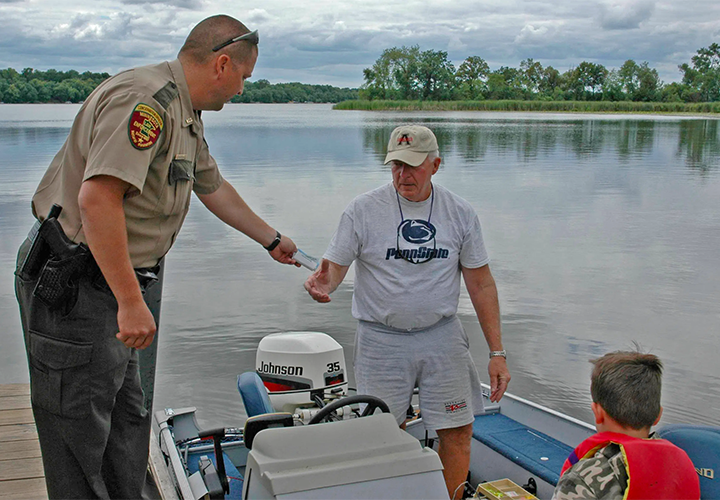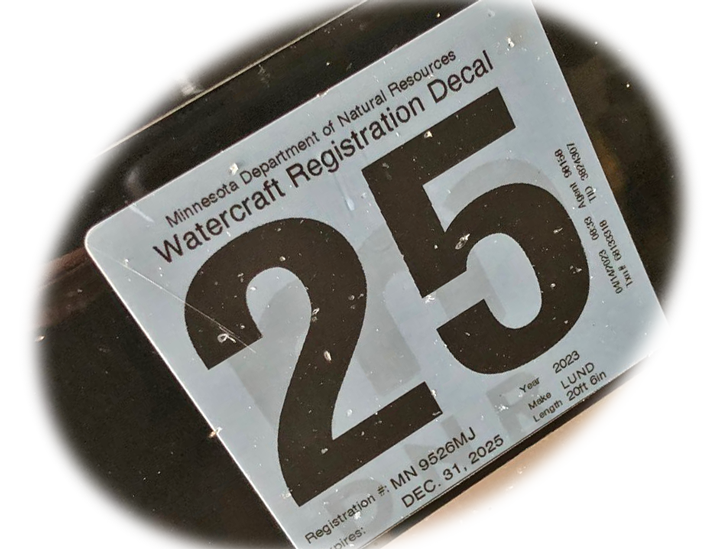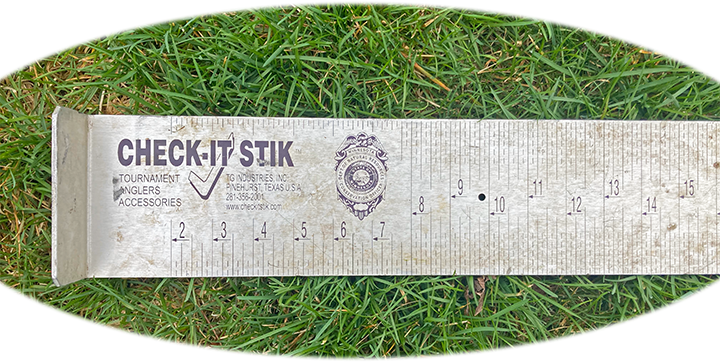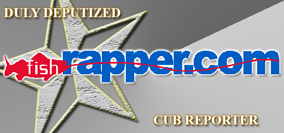
Feature Articles Section May 1, 2025 "Don't Land A Citation! Avoid These Embarrasing, Sometimes Costly Fishing-Boating Violations"
 May 1, 2025 "Avoid Embarrasing and Costly Fishing and Boating Violations" • Jeff Sundin
May 1, 2025 "Avoid Embarrasing and Costly Fishing and Boating Violations" • Jeff Sundin
 Every year, I’m amazed by the number of encounters I have with folks who commit innocent, but potentially expensive, fishing violations. Admittedly, many of the violations do not amount to anything like “crimes of the century”, but they can be both embarrasing, and costly. AND, if they’re serious enough to warrant a citation, then they’re serious enough for us to talk about here.
Every year, I’m amazed by the number of encounters I have with folks who commit innocent, but potentially expensive, fishing violations. Admittedly, many of the violations do not amount to anything like “crimes of the century”, but they can be both embarrasing, and costly. AND, if they’re serious enough to warrant a citation, then they’re serious enough for us to talk about here.
With the assistance of Minnesota DNR Enforcement, Lieutenant Colonel, Robert Gorecki, and Communications coordinator, Joe Albert, I put together a list of the more common offenses anglers make every year. To get assessments from varying geographic regions, Albert consulted with conservation offers (CO-s) from across Minnesota.
One caveat, the list I’m presenting does not cover every conceivable fishing violation, for that, you NEED to read the MN Fishing Regulations Book. Instead, this list represents some of the most common violations that CO-s encounter in their daily work. Knowing and following these guidelines will help keep you out of embarrassing and potentially expensive jams with your local game warden.
First up on the list, are comments from MN DNR CO Pat McGowan, stationed in Walker, MN and works on lakes in the Walker region. Frequently, McGowan patrols Leech Lake and connected waters.
 Watercraft registration issues, especially during the early weeks of the fishing season. “I often see expired registrations the first couple of weeks into the open-water season. This is a common violation on the opening of fishing weekend, too.” McGowan says. “When we complete checks on anglers in watercrafts, we are asking for safety equipment as well. Life jackets, fire extinguishers, and sound-producing devices are items that we often find missing.” He added.
Watercraft registration issues, especially during the early weeks of the fishing season. “I often see expired registrations the first couple of weeks into the open-water season. This is a common violation on the opening of fishing weekend, too.” McGowan says. “When we complete checks on anglers in watercrafts, we are asking for safety equipment as well. Life jackets, fire extinguishers, and sound-producing devices are items that we often find missing.” He added.
“After sunset, boaters on the water without navigational lights are a common problem. No fishing license in possession and fishing with extra lines are also violations that I run into during the open-water season.” McGowan concluded.
Mankato, MN area CO Jamie VanThuyne writes, “The most common fishing violation in my area is when anglers fail to have a fishing license. Besides not possessing a fishing license, another common violation is possession of under-sized northern pike. In the southern pike zone, anglers may possess two (2) northern pike, and the minimum size is 24.0 inches. Another common violation in my regions occurs when bowfishing anglers illegally dispose of carp in an irresponsible manner. Fish captured by bowfishing must not be discarded along the shoreline, or along public roadways. They should be removed from the lake by the angler and disposed of in the trash, or other approved methods.
La Crescent, MN area and Mississippi River CO Tyler Ramaker says, “When fishing for species subject to any minimum or maximum length requirement, it is important to have a reliable and standardized measuring device. Anglers who use measuring marks on their fishing poles, coolers, or even their size 12 boot to measure fish often get inaccurate results. Conservation officers measure fish on standardized, commercially made “bump boards” with the fish’s mouth closed and its tail pinched. COs recommend anglers use this method as well so we can all get the same measurement.
Blackduck, MN and Upper Red Lake CO Brice Vollbrecht echoes earlier comments. “During the first couple of weeks, or even throughout the open-water season, I see anglers consistently forgetting to bring boating safety equipment in the boat and not checking for that equipment before leaving the dock. This includes PFDs, throwable PFDs and fire extinguishers.
Individuals commonly forget to check that boat registration is up-to-date, especially early during the open-water season.
As far as fishing violations, on the big lakes around here, where there are slot size regulations, individuals could easily avoid citations/warnings by purchasing a good measuring board and not trying to use a sticker on the side of their boat or a tape measure. If they have a measuring board, they allows laying the fish flat, they’ll get a better measurement.
Roseau, MN area and Lake of the Woods CO Ben Huener advises, “The easiest violation to avoid is angling with too many lines. It’s an understandable temptation to experiment with different color or techniques with an additional line, but you can’t give in to it. During the open water angling season, keep it to one line per active angler and you’ll avoid receiving a citation.
Alexandria, MN area and with the statewide Marine Unit, CO Mitch Lawler agrees with other Co-s about folks fishing without licenses. From Lawler’s my viewpoint, the most common violation he encounters during every season of the year is license-less angling. “This violation occurs on every water body, at all times of year, and the excuses reasons for it span the gamut.” Lawler says.
“Anglers either choose not to purchase a fishing license because they don’t fish often or are only in town for a couple days. Some aren’t planning on keeping any fish so they don’t think a license shouldn’t be required. Anglers often assume that their spouse has purchased the license, but after searching, realize neither one purchased it or bothered to check.” He adds.
Babitt, MN are and BWCA CO Anthony Bermel chimed in about extra lines. “This is typically an intentional violation, but I do get people coming up from other states that use the excuse that they can use more than one rod where they live/fish so figured they could here too. It’s an easily avoidable violation that will result in a ticket every time you get caught.” Bermel says.
Adding to the comments about fishing licenses, Bermel added, “Fishing license violations are common in the BWCAW but are easily avoidable by being sure that you get your timing right. Fishing with a license before or after the valid timeframe is common. Be sure that your 72-hour, or other short duration license is valid for the times and dates that you’ll be fishing. Planning ahead is critically important too! People often count on buying their license online, along their way to their entry point, but discover that they can’t because of poor phone reception or some other problem. Buy your license well before you plan to use it, then you’ll have alternative options in case your primary purchase plans fail.”
I’m going to wrap up this article by offering a couple observations of my own. One very common violation that I personally encounter in my travels every summer is the possession of fish that exceed certain maximum or minimum size restrictions. Except for sunfish, and yellow perch, Minnesotans are not allowed to possess more than one “daily bag limit” of fish. This rule applies to all other species of game fish and means that once you’ve put a single “daily limit” of fish in your freezer, you are no longer allowed to harvest additional fish of that species.
In Minnesota, fish possession rules include fish species that are subject to special size restrictions. For example, Minnesota allows legal anglers, or legal recipients of gifted fish, the possession of one (1) walleye over 20 inches long. What this means is that if any angler who harvests and possesses 1 walleye over 20 inches, they may not harvest another one over 20 inches until they’ve consumed, or gifted away, the first one. In north central Minnesota, there are similar size restrictions for northern pike.
 Measuring fish, mentioned several times by MN DNR COs prompted me to contact Joe Albert with a follow up Question. I asked,
Measuring fish, mentioned several times by MN DNR COs prompted me to contact Joe Albert with a follow up Question. I asked,
Q) Do the COs favor one brand, style or “certification” of the ruler an angler uses for measuring fish? And If an angler uses a quality, commercially produced ruler, and a fish measures legally on it, will a CO make allowances for slight variances from the ruler that the CO uses to measure the same fish?
A) Albert. “As a rule, we don’t endorse or recommend a particular brand/company. All we want is something that provides an accurate measurement of the fish. We generally advise people not to use the “tape/sticker” type rulers since they shrink, crack, tear, etc., in the sun and elements, which can result in an inaccurate measurement.
Also, measuring boards that have a front edge/raised portion that the nose of the fish can rest against generally give more accurate measurements as it takes the guesswork out of whether the nose is over/behind the 0-inch mark. Also, metal boards generally last longer and are less likely to crack in extreme cold weather.
We have found very little to no variation from one commercial manufactured measuring board to another. Nearly all the measuring errors we see are from human error, either intentionally or accidentally.
 As with all violations, officers take the totality of the circumstances into account on what type of action is taken. If it is a matter of an issue of the board being slightly inaccurate, but the angler was otherwise acting in good faith, that is considered when making a decision. A citation/ticket is just a tool that is used to ensure people are following the law. If a citation isn’t needed to change the behavior or intent, then we typically don’t issue citations.”
As with all violations, officers take the totality of the circumstances into account on what type of action is taken. If it is a matter of an issue of the board being slightly inaccurate, but the angler was otherwise acting in good faith, that is considered when making a decision. A citation/ticket is just a tool that is used to ensure people are following the law. If a citation isn’t needed to change the behavior or intent, then we typically don’t issue citations.”
MN DNR CO, Tom Sutherland, Grand Rapids, MN provided the photo right, of the meausing stick or "bump board" he uses on the job. This is the ruler most of the COs in the Grand Rapids region use, says Sutherlund, who added this advisory. “It’s critical that anglers learn and practice the correct method for measuring fish. A proper measurement is achieved by closing the fish’s mouth, pressing the nose against the leading edge of the “bump board” and gently pressing the tail together”. Sutherland says.
According to Sutherland, 99 out of 100 fish length violations are due to improper measuring techniques, not because of inaccurate measuring devices. If it shows up wrong on his ruler, it is most likely also wrong on the angler’s ruler when measured correctly.
As it happens, I've been shopping for a new bump board myself and hadn't been satisfied with the offerings I'd found so far. So, I did a quick search for the semi-official stick used by Sutherland. It didn't take long to find a company called T&G Industries in Pinehurst, TX. They do still sell the "Check-IT Stik" and offer several models. I ordered the 36 X 6 inch red finish model and I'll happily share a review of it next week, when it arrives.
Occasionally, I find myself on a lake where someone catches an unexpected fish, or I’ve forgotten to check for the lake’s specific “special regulations”. When that happens, I use the MN DNR Recreation Compass to quickly learn whether that lake has a special regulation or size restriction that I need to know about. This is the best tool on the internet for Minnesota anglers. In 4 clicks, you can learn “everything” there is to learn about the lake you’re on, and with today’s improved cell phone coverage, rarely fails me.
Summing it up, make sure you use this checklist before you head for the lake, and you’ll be ready, mostly, for a safe and productive day of fishing in Minnesota.
- Boat Registration and up-to-date decals
- Life Jackets (1 for every angler)
- Throwable PFD (1 for the boat)
- Horn, or portable sound device
- Navigation, mooring lights (required before and after sunset)
- Fishing License in possession or loaded on your phone
- No extra fishing lines
- Approved commercially produced ruler or “bump board” for measuring fish
- MN DNR Recreation Compass bookmarked on your phone
 Join And Become A Duly Deputized Fishrapper Cub Reporter
Join And Become A Duly Deputized Fishrapper Cub Reporter
Helping your fellow fishermen and women stay abreast of the fishing conditions in your area is good for everyone and it's easier than you think!
Fishing Reports Minnesota is the Facebook counterpart to this page and it's open to the public. Be like me, become a duly deputized "Cub Reporter" and post your own pics and comments. If it's good for fishing, then it's Good For Everybody!